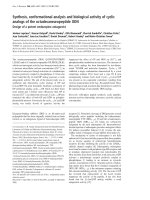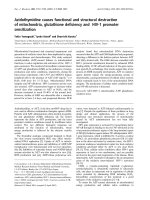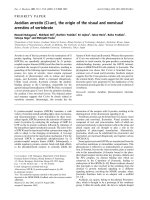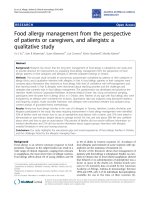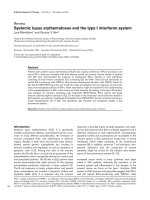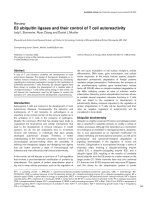Báo cáo y học: "Hemofiltration, adsorption, sieving and the challenge of sepsis therapy design" ppsx
Bạn đang xem bản rút gọn của tài liệu. Xem và tải ngay bản đầy đủ của tài liệu tại đây (41.81 KB, 4 trang )
IL = interleukin; IM = inflammatory mediators; MWCO = molecular weight cut-off; SC = sieving coefficient.
Critical Care October 2002 Vol 6 No 5 Honoré and Matson
Circulating inflammatory mediators (IM) spilling into the
circulation from sites of active inflammation are considered the
source of remote tissue injury and associated organ dysfunction
in sepsis. Hemofiltration has been proposed as a therapy for
sepsis based on its ability to remove circulating IM by sieving or
by adsorption, or both. Designing devices and methods for
sepsis therapy will require optimization of these two
mechanisms. In the present issue of Critical Care Forum,
Kellum and Dishart report the relative effects of sieving and
adsorption on plasma IL-6 following cecal ligation and puncture
in rats [1]. The authors conclude that hemoadsorption is the
main mechanism of removal, and discuss some possible
implications for filter design. Hemoadsorption is dependent on
membrane material and filtration operating parameters (e.g.
filtration fraction: the so-called adsorption/synergistic effect).
If hemofiltration is to be an effective therapy in the
complexity of sepsis, then proper design of its material and
operational characteristics must be pursued. Adsorption of
proteins to membrane materials is well recognized in
pharmaceutical manufacturing, food processing and medical
filtration. The type and extent of feed solution proteins
adsorbed depends on the membrane material, the pH, ionic
strength and composition of the feed solution, the pore size,
the membrane morphology and the presence of a
polarization layer.
Membrane materials vary in the extent and type of cytokines
adsorbed. Data from in vitro studies reveal tumor necrosis
factor adsorption of 30–32% for polyamide and AN69, and
of 0% for cellulose acetate and polysulfone. IL-1 adsorption
Commentary
Hemofiltration, adsorption, sieving and the challenge of sepsis
therapy design
Patrick M Honoré
1
and James R Matson
2
1
Consultant in Intensive Care Medicine, General Intensive Care Unit, St Pierre Hospital, Ottignies-Louvain-La-Neuve, Belgium
2
Consultant in Pediatric Critical Care Medicine, Medical City Hospital, Dallas, Texas,USA
Correspondence: Patrick M Honoré, and
Published online: 4 September 2002 Critical Care 2002, 6:394-396
This article is online at />© 2002 BioMed Central Ltd (Print ISSN 1364-8535; Online ISSN 1466-609X)
Abstract
Circulating inflammatory mediators spilling into the circulation from sites of active inflammation are
considered the source of remote tissue injury and associated organ dysfunction in sepsis.
Hemofiltration has been proposed as a therapy for sepsis based on its ability to remove circulating
inflammatory mediators by sieving or by adsorption, or both. Designing devices and methods for sepsis
therapy will require optimization of these two mechanisms. In the present issue of Critical Care Forum,
Kellum and Dishart report the relative effects of sieving and adsorption on plasma IL-6 following cecal
ligation and puncture in rats. The authors conclude that hemoadsorption is the main mechanism of
removal, and discuss some possible implications for filter design but hemoadsorption is well
dependant on hemofiltration (the so-called hemofiltration filter adsorption/synergistic effect). It is
important to recognize the limitations of conventional systems; Kellum and Dishart have extended our
knowledge of hemofiltration filter adsorption, which is quite different from conventional
hemoadsorption. If sepsis is a manifestation of a nonlinear dynamic control system out of control, then
filtration at modest doses with a large pore filter may succeed as well as high-volume hemofiltration
with a conventional cut-off filter. In the present paper, we will explore the strengths and the
weaknesses of the ‘Kellum and Dishart’ study and discussing their findings in the light of the current
available literature.
Keywords adsorption, hemofiltration, membrane, sepsis, sieving
Available online />was 40% for polyacrylonitrile, 0–11% for polysulfone, 2% for
AN69 and 0% for polyamide [2,3]. Birk et al. found an
approximately sixfold difference in total plasma protein
adsorption between different membrane materials. Total
protein adsorption was negatively correlated with the
adsorption of proteins with molecular weight < 65 kDa [4].
The feed solution pH and ionic strength significantly affect
adsorption and polarization, as shown in vitro. At pH 4.8, the
sieving coefficient (SC) for albumin and the SC for IgG are
~0.45 and 0, respectively. At pH 7.4, however, these SCs
are 0.38 and 0.85, a substantial reversal [5]. At equal
concentration, mixtures of IgG and albumin reduce filtrate flux
and protein diffusivity more than pure solutions; this results
from protein–protein interactions [6]. Generally, these factors
cannot be manipulated in clinical hemofiltration.
Membranes with a higher molecular weight cut-off (MWCO)
adsorb more protein than lower MWCO membranes. Uptake
of radiolabeled albumin by a 100 kDa MWCO polysulfone
membrane was nearly double that of a 30 kDa MWCO
membrane [7]. Protein uptake occurred preferentially in larger
pores [8]. This pattern of protein uptake has significant
implications for molecular sieving. Molecular sieving in AN69
membranes was characterized using polydisperse dextran
before and after blood contact. The SC for dextran of
molecular weight < 5 kDa was reduced by 14%, and the SC
for 20 kDa dextran was reduced by 60% [9].
Protein (including cytokine) adsorption and polarization of
filtration membranes have been extensively studied.
Awareness of these characteristics is essential in designing
filtration therapy for sepsis. Some design elements relevant
to adsorption are fixed for a given system (e.g. membrane
materials, morphology and surface area), and some do not
permit manipulation (e.g. patient plasma protein composition,
pH and ionic strength). However, as membrane adsorption is
rapidly saturated (30 to 50 minutes) [9,10]. Recent
recognition that the intensity of ultrafiltration needs to be
adjusted for patient body size and severity of illness [11,12]
supports the need to focus on sieving and filtrate flow as
promising points for new designs.
The design of blood filtration in sepsis should focus on those
characteristics of hemofiltration that permit greater
effectiveness in controlling sepsis and that provide
operational flexibility so the therapy may be tuned to patient
body size and severity of illness. This process begins with
recognition of key features of the inflammatory response. The
network of IM, acting as a nonlinear dynamic control system,
drives the inflammatory response [13,14]. Network effects
make the inflammatory response robust against large
narrowly focused changes [15]; this robustness probably
explains the failure of drugs directed against some single IM
[14]. Control networks may be manipulated by application of
small changes in the activity to many network elements. The
more elements (e.g. IM) affected, the smaller the change in
their aggregate activity required for system control. Applied
to blood filtration in sepsis, either high doses of filtration with
a conventional filter, or lower doses with a large pore filter
should be effective.
In their study, Kellum and Dishart used an appropriate animal
model (ceacal ligation and puncture) relevant in its initial
insult and delay in treatment. According to the average body
weight for adult, male Sprague-Dawley rats reported (486 g)
and to the ultrafiltration flow rate(Quf) reported (30 ml/hour),
we can conclude that a dose of ~62 ml/kg (which for a 75 kg
human being represent 4.5 l/kg per hour) was delivered.This
dose is greater than the highest dose used by Ronco et al.
(45 ml/kg per hour) [11] and clinically relevant as high-
volume hemofiltration is usually defined to be greater than
50 ml/kg per hour [16]. However when looking at literature,
usual average body weight for adult, male Sprague-Dawley
rats is about 580 g [17].
In the study of Kellum and Dishart, Quf was not controlled or
indexed to body weight. Recent [11,12] demonstrations of
dose-response effects of hemofiltration in human acute renal
failure and sepsis make indexing Quf to body weight a critical
parameter to assess or control. Filter blood flow was
spontaneous and not quantified; however the high Quf
suggest an high filtration fraction prevailed. Low filtration
fraction promotes IM sieving, high filtration fraction promotes
adsorption and reduces sieving of IM [18].
What evidences support effective sieving of IM in sepsis?
Honore et al. replaced 35 l of ultrafiltrate in 4 hours (using
high-volume hemofiltration) in 20 patients with refractory
septic shock using a polysulfone membrane (Fresenius,
MWCO = 35 kDa) [12]. Predicted mortality for the group
was 79%, and observed mortality was 55% (P < 0.05).
Patients who responded (improved to specified end points)
hemodynamically by the end of the 4 hours survived
significantly more often (9/11) than those patients that did
not respond (0/9 survived 24 hours).
Retrospective analysis of the study of Honore et al. [12]
revealed that responders were smaller (66.2 ± 8.4 kg) than
nonresponders (82.6 ± 13.4 kg) and therefore received a
larger dose of filtration (0.53 ± 0.07 l/kg per 4 hours
[±150 ml/kg per hour of hemofiltration clearance indexed to
body weight and time] and 0.43 ± 0.07 l/kg per 4 hours
[±110 ml/kg per hour of hemofiltration clearance indexed to
body weight and time], respectively). Retrospective analysis
of the study of Honore et al. [12] suggests that a sufficiently
high dose allows ~82% improvement in survival. The same
protocol applied to all patients, thus adsorption should be
similar in all patients; adsorption should be saturated by 30
to 50 minutes [9,10]. Thus the dominant mechanism of IM
removal should be sieving. Survival was not assess in the
study of Kellum and Dishart [1].
Critical Care October 2002 Vol 6 No 5 Honoré and Matson
A large pore filter (polysulfone, MWCO = 100 kDa) has been
used in a swine model of lethal sepsis [19]. In a paired study
with a similar conventional filter (MWCO = 50 kDa), and
using identical operating parameters (e.g. equal filtration
fraction) the 100 kDa filter was associated with a survival
time nearly twice that of the 50 kDa filter. A similar filter
(polyamide, MWCO = 100 kDa) has been studied in vitro by
Uchino et al. using recirculating human blood [20]. The blood
was spiked with endotoxin to raise a cytokine response.
Selected results are compared in Table 1 with conventional
filters [20–23].
The 100 kDa membrane has two significant advantages.
First, for IM sieved by conventional and the 100 kDa
membrane, the 100 kDa exhibits higher SC. Second, the 100
kDa sieves cytokine not sieved by conventional membrane.
If sepsis is a manifestation of a nonlinear dynamic control
system operating at an excessive and injurious level, then
filtration at modest doses with a large pore filter may
succeed; high-volume hemofiltration with a conventional
MWCO should also be effective.
A successful blood filtration therapy for sepsis and septic
shock will not be found by accident — it will be designed. It is
important to recognize the limitations of conventional
systems. Kellum and Dishart have shown that hemofiltration
filter adsorption occurs and exhibits meaningful biologic
effects.
The design of successful blood filtration therapy in sepsis will
require recognition of the limitations of existing systems and
methods. The Kellum and Dishart study aids this recognition.
Recognition that IM are not operative as single agents, but
are closely integrated in a self-regulated control network
[13–15] is of key importance to design of therapeutic
systems. A blood filtration system which filters a sufficiently
wide of IM to be effective in sepsis, and has the operation
flexibility to readily adapt to patients of different body size and
severity of illness will require careful design. In matters of
membrane separation and system control, our engineering
colleagues have much to offer.
Partnering with industry and engineering should allow new
devices and methods to be developed and tested. This
should be done before we embark upon a large scale
multicentre study [24]. By viewing the whole problem, we
can work out the whole solution.
Competing interests
None declared.
References
1. Kellum JA, Dishart MK: Effects of hemofiltration on circulating
IL-6 levels in septic rats. Crit Care Forum 2002, 6:429-433.
2. Lonnemann G, Koch K, Shaldon S, Dinarello C: Studies on the
ability of hemodialysis membranes to induce, bind, and clear
human interleukin-1. J Lab Clin Med 1988, 112:76-86.
3. Goldfarb S, Golper T: Proinflammatory cytokines and hemofil-
tration membranes. J Am Soc Nephrol 1994, 5:228-232.
4. Birk H-W, Kistner A, Wizemann V, Schutterle G: Protein adsorp-
tion by artificial membrane materials under filtration condi-
tions. Artificial Organs 1995, 19:411-415.
5. Saksena S, Zydney A: Effect of solution pH and ionic strength
on the separation of albumin from immunoglobulins (IgG) by
selective filtration. Biotechnol Bioeng 1994, 43:960-968.
6. Saksena S, Zydney A: Influence of protein–protein interactions
on bulk mass transport during ultrafiltration. J Membrane Sci
1997, 125:93-108.
7. Robertson B, Zydney A: Protein adsorption in asymmetric
ultrafiltration membranes with highly constricted pores.
J Colloid Interface Sci 1990, 134:563-575.
8. Mochizuki S, Zydney A: Effect of protein adsorption on the
transport characteristics of asymmetric ultrafiltration mem-
branes. Biotechnol Prog 1992, 8:553-561.
9. Langsdorf L, Zydney A: Effect of blood contact on the transport
properties of hemodialysis membranes: a two-layer mem-
brane model. Blood Purif 1994, 12:292-307.
10. Khulbe KC, Matsuura T: Study of fouling of ultrafiltration mem-
brane by electron spin resonance. J Membrane Science 2000,
167:263-273.
11. Ronco C, Bellomo R, Homel P, Brendolan A, Dan M, Piccini P, La
Greca G: Effects of different doses in continuous veno-
venous haemofiltration on outcomes of acute renal failure: a
prospective randomized trial. Lancet 2000, 356:26-30.
Table 1
Sieving coefficients of large pore membranes and conventional pore membranes
Cytokine
IL-8 TNFα IL-1 IL-10 IL-6 Albumin
Operating (MW = (MW = (MW = (MW = (MW = (MW =
Membrane characteristics 8 kDa) 17 kDa) 17 kDa) 17 kDa) 26 kDa) 69 kDa)
100 kDa polyamide [20] 1 l/h 0.31 0.27 0.81 0. 56 0.73 0.06
6 l/h 0.19 0.09 0.75 0. 56 0.32 0.0
Polyamide* [21] Variable 0.25 0 0.18 0
Polysulfone* [22] 0.12 0.22 0.42 0 0.04
AN69** [23] 0.08 0.16 0.22 0 0.18
TNFα, tumor necrosis factor alpha; MW, molecular weight. Mean molecular weight cut-off (MWCO) of 30 kDa is shown in the table by the sign *
and the MWCO of 50 kDa is shown in the table by the sign **.
Available online />12. Honore PM, Jamez J, Wauthier M, Lee Pa, Dugernier T, Pirenne B,
Hanique G, Matson JR: Prospective evaluation of short-term,
high-volume isovolemic hemofiltration on the hemodynamic
course of and outcome in patients with intractable circulatory
failure resulting from septic shock. Crit Care Med 2000, 28:
3581-3587.
13. Asachenkov A, Marchuk G, Mohler R, Zuev S: Immunology and
disease control: a systems approach. IEEE Trans Biomed Eng
1994, 41:943-953.
14. Neugebauer E, Willy C, Sauerland S: Complexity and non-
linearity in shock research: reductionism or synthesis? Shock
2001, 16:252-258.
15. Callard R, George A, Stark J: Cytokines, chaos, and complexity.
Immunity 1999, 11:507-513.
16. Honore PM, Jamez J, Wauthier M, Pirenne B, Pelgrim JP,
Dugernier T: Removal of mediators by hemofiltration in septic
shock: where do we stand? Reanim Urgences 2000, 9:289-
297.
17. Taconic website, />18. Lee PA, Matson JR ,Pryor RW, Hinshaw LB: Continuous arteri-
ovenous hemofiltration therapy for Staphylococcus aureus-
induced septicemia in immature swine. Crit Care Med 1993,
21:914-924.
19. Lee PA, Weger G, Pryor RW, Matson JR: Effects of filter pore
size on efficacy of continuous arteriovenous hemofiltration
therapy for Staphylococcus aureus-induced septicemia in
immature swine. Crit Care Med 1998, 26:730-737.
20. Uchino S, Bellomo R, Goldsmith D, Davenport P, Cole L, Baldwin
I, Panagiotopoulos S, Tipping P: Super high flux hemofiltration:
a new technique for cytokine removal. Intensive Care Med
2002, 28:651-655.
21. Hoffmann J, Werdan K, Hartl W, Jochum M, Faist E, Inthorn D:
Hemofiltrate from patients with severe sepsis and depressed
left ventricular contractility contains cardiotoxic compounds.
Shock 1999, 12:174-180.
22. Heering P, Morgera S, Schmitz F, Willers R, Schulteiss HP,
Strauer BE, Grabensee B: Cytokine removal and cardiovascu-
lar hemodynamics in septic patients with continuous veno-
venous hemofiltration. Intensive Care Med 1997, 23:288-296.
23. De Vriese A, Colardyn F, Philippe JJ, Vanholder RC, Desutter JH,
Lameire NH: Cytokine removal during continuous hemofiltra-
tion in septic patients. J Am Soc Nephrol 1999, 10:846-853.
24. Honore PM, Matson JR: Short-term high-volume hemofiltration
in sepsis: perhaps the right way is to start with. Crit Care Med
2002, 30:1673-1674.


